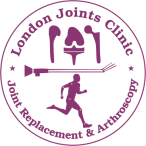Acromioclavicular Joint
Injuries
The Acromioclavicular joint (ACJ) is formed by the outer end of the clavicle (collar bone) and a part of the shoulder blade called the acromion process. This joint is located above the shoulder joint and is easily felt at the top of the shoulder.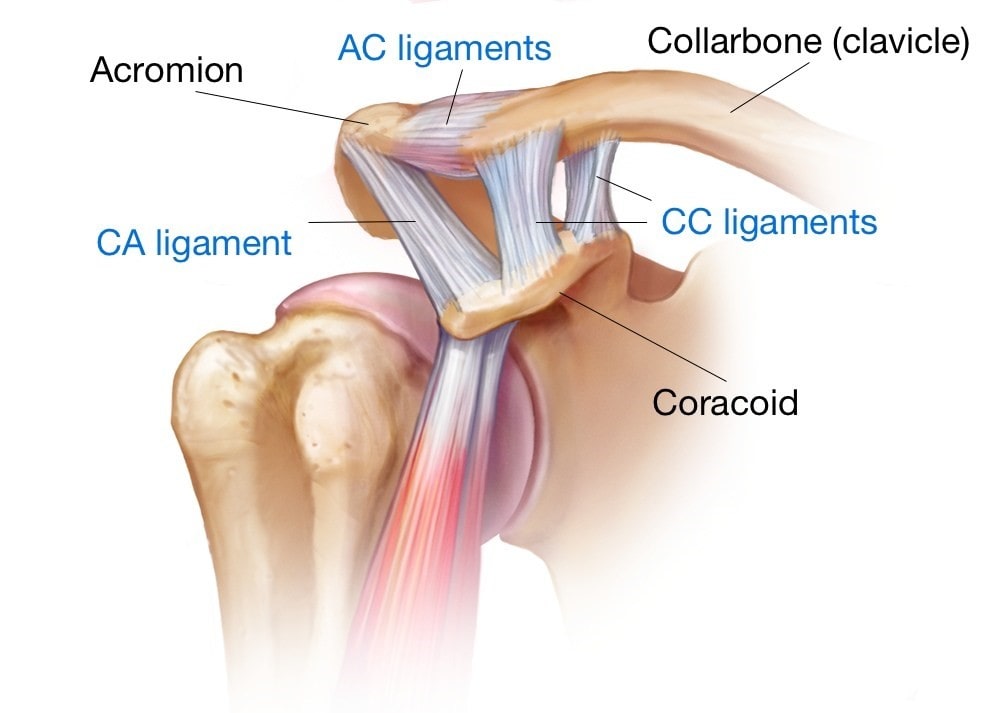
The AC joint is surrounded by thick and strong joint capsule. Additional stability is provided by the acromioclavicular (AC) ligaments and the coracoclavicular (CC) ligaments.
The coracoclavicular ligament runs from the top of the coracoid process to the under-surface of the clavicle. It consists of a conoid part on the inner side and a trapezoid part on the outer side. It provides stability in a vertical plane.
The acromioclavicular ligaments are strong superior and posteriorly. These provide stability in a horizontal plane.
AC joint injuries can occur due to:
- Fall on an outstretched hand or elbow
- Direct trauma to the lateral shoulder or acromion process with the arm in adduction.
These injuries account for 9 % of total shoulder girdle injuries. These are very common in athletic population and can account for 40 to 50 % of shoulder injuries in several contact sports.
The AC joint injuries are diagnosed based on patient’s history of injury, clinical examination of the shoulder region and appropriate investigations.
Patient develops pain, swelling, bruising and may have bump deformity around the top of the shoulder. They have difficulty with overhead activities. The is tenderness over the AC joint and painfully limited shoulder mobility.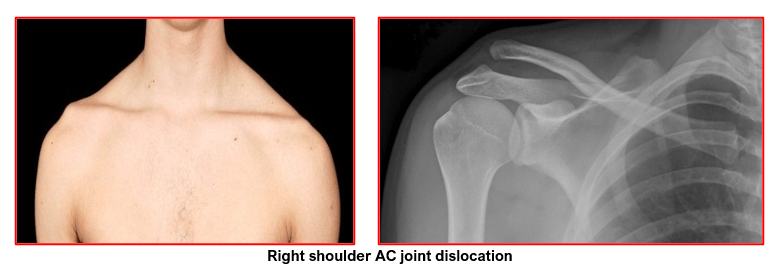
X-rays of the shoulder can show AC joint injuries with any associated fractures. This helps in diagnosing the AC joint injury and also establishing its severity.
CT scan and MRI scan are very rarely needed for making a diagnosis.
There are various types of classifications for AC joint injuries. The severity of these injuries depends upon the severity of the damage to its stabilising ligamentous tissues. Injury to AC ligaments is not considered serious but injuries to CC ligament affect the whole shoulder girdle and hence are considered serious. There are six grades of AC joint injuries.
Type I: Sprain of the AC ligament. The AC or CC ligaments are intact.
Commonest injury
Type II: Tear of the AC ligament. CC ligaments intact.
Type III: Both the AC & CC ligaments are torn. There can be 25% to 100%
displacement of the clavicle compared to opposite side.
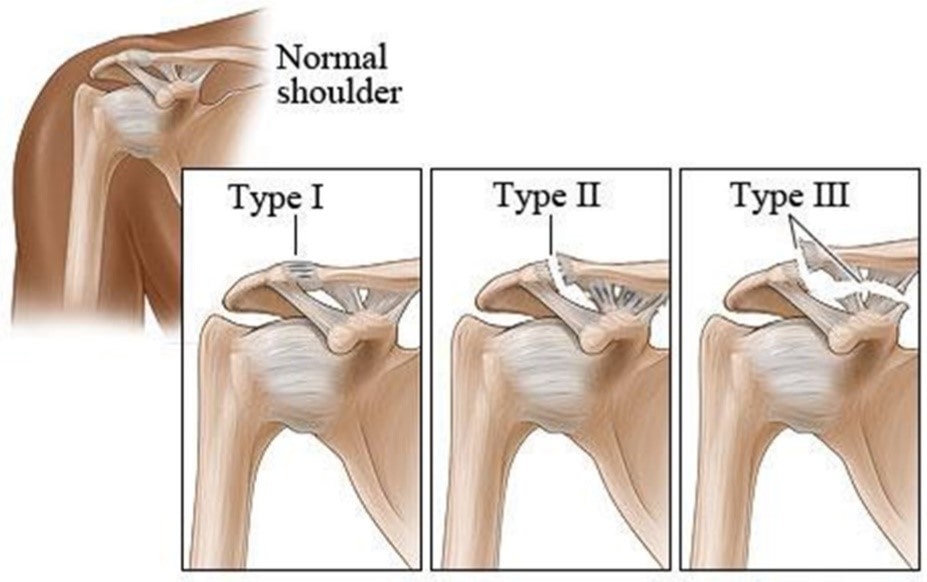
Grades IV to VI are uncommon and occur due to high energy injuries like motor vehicle accidents. These injuries are serious ones and normally need surgery.
- Patients are given a shoulder pouch that supports the elbow. It provides support and helps reduce pain. The shoulder pouch may be needed for 2 to 3 weeks until the pain settles down.

• Ice packs are advised 4 to 5 times a day to reduce swelling and pain. • Painkiller medications are taken as needed for the first few days. • Overhead activities are avoided until pain settles down. • Gentle shoulder exercises are started soon and gradually progressed through, based on tissue healing and reduction of pain. • Majority of patients heal by 3 months. The patients should have full range of movements, no local tenderness and no instability on probing and stressing the AC joint. Patients can return to high intensity sports by 3 months if they have healed well. Some patient will have a mild cosmetic deformity of prominence of the lateral end of clavicle. But it causes no functional limitations.
Surgical treatment is advised for AC joint injury if there is:
- Failure to respond to conservative treatment
- Ongoing pain or instability even after 3 months with overhead activities in sportsmen.
- Young patients involved with contact sports & heavy manual work.
There are several surgical techniques for stabilisation of the AC joint.
The most commonly performed surgery involves reconstruction of the coracoclavicular ligaments with a hamstring tendon graft and excision of the lateral end of the clavicle. The graft could be reinforced with specialised suture tapes. These surgeries can be done arthroscopically assisted or with open technique.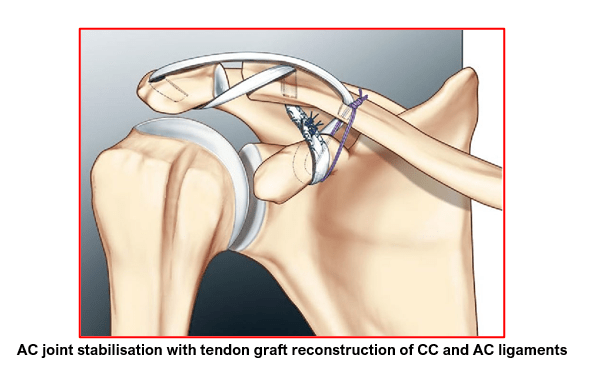
The outer 10 -15 mm of the clavicle is excised and then the AC ligament is transferred from the bottom of the acromion into the cut end of the clavicle to replace the torn ligament.
The complications associated with AC joint injuries are:
- Persistent cosmetic deformity
- Persistent instability of the shoulder girdle
- Pain at the AC joint
- Difficulty with overhead activities during contact sports and work
- Failure of fixation devices used for stabilisation of AC joint
- Scar hypertrophy
- Damage to blood vessels and nerves
- Development of AC joint arthritis
Book An Appointment
Private Clinics : Locations & Directions
London Joints Clinic (Pune)
Address
Office S 5, 2nd Floor, North Block, Sacred World Mall,
Opp Sacred Heart Township, Near Jagtap Chowk,
Wanawadi, Pune 411040
Monday to Saturday
6 PM to 9 PM
Appointments
Hospitals OPDs : Locations & Directions
Jupiter Hospital (Baner)

Address
Lane 3, Baner- Balewadi Road,
Prathamesh Park,
Baner, Pune 411 045
Monday to Saturday 11 AM to 4 PM
Appointments
Contact us
Dr Anand Jadhav has a centralised appointment system for all locations across various hospitals and clinics in Pune & PCMC areas
Appointment Bookings & Requests can be made by any method :

